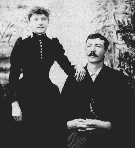

Butte County was created by an act of the Territorial Legislature of 1883. The commissioners appointed to organize the county government were Henry Chamberlain, J. I. Woolsten, and Christian Flucken. The first meeting of the commissioners was held at Minnesela on July 23, 1883. Being the only town of any importance in the county at that time, Minnesela was made the temporary county seat.
On March 25, 1894, when I came to Butte County to take charge of the Belle Fourche Bee, Henry Chamberlain conducted a meat market in Belle Fourche, and J. I. Woolsten was state's attorney. My advent into the county was in the wake of one of the worst blizzards in the history of northwestern S.D., arriving (sic) on the first train through from Whitewood for the past four days. I remember a snowdrift 15 feet high was piled on the crosswalk between Tom Gay's store and the Railroad Hotel, with a tunnel bored through it, and that drift survived for several days. Range stock losses were severe.
It was nearly a week before anyone was able to get through the snowdrifts to Belle Fourche from the north. The first two men to arrive from the north were E. A. Mulkey and Red Smith. They came on horseback.
Minnesela maintained its position as county metropolis up until 1891 when Belle Fourche was created by the Pioneer Townsite Company, a railroad subsidiary. And thereby hangs a tale.
In 1890, when the F. E. &M. V. (later the Chicago and Northwestern) Railroad revealed it's plans to extend it's line from Whitewood, it brought a thrill to Butte County residents, and it was taken for granted by everyone that the railroad would build to Minnesela. In fact, the company right-of-way agent had negotiated for depot site and railroad yards, and everything was looking rosy, expecially for the Minnesela real estate boomers.
At about this time, one of the get-rich-quick gentry discovered a tract of open government land, just south of Minnesela, that had been overlooked by the right-of-way agent. He filed on the tract and then demanded a huge sum for a right-of-way across it. This marked the beginning of the end for Minnesela.
The S&B ranch company (Star and Bullock) donated the rail company 40 acres of land for a townsite along the river, just above the mouth of Redwater creek. The railroad changed its routing to pass up Minnesela by nearly half a mile, and laid the rails through in time to ship out many trainloads of range cattle the fall of 1890.
That was the inception of Belle Fourche as a railroad town. The first lot sale was in June 1891, and within a few months the new town became the county metropolis.
When it was decided in 1894 the time had come to seek the permanent county seat, Belle Fourche citizens financed the erection of a two-story frame building to be donated to the county for a courthouse. The structure was practically completed before election day.
Minnesela was preparing to fight for retention of the county capital, and it was generally conceded that the old town would command a heavy vote from down-river, especially in the more populous Vale and Empire districts.
To help split up the down-river vote, the Belle Fourche boosters conceived a plan to enter a third candidate for county seat. A townsite was platted down the valley in the center of the county, across the river from present-day Nisland, and "Prairie City" was petitioned to be placed on the election ballot as a candidate for county seat. Learning of this maneuver, the Minneselans rushed into circuit court for a writ of injunction. The court ruled, however, that no names of towns should appear on the ballot; instead, the words "For Permanent County Seat", followed by a blank space for voters to write in their choice, would be included.
A month of so before election day, the railroad company happened to discover its roadbed within Butte County was in need of repair, and brought in a crew of 30 or 40 laborers, all single men. Under the existing laws, thirty days residence in the county made them eligible voters. Also, it was remarkable how so many cowboys from far outlying ranches happened to converge on Belle Fourche right at election time. At any rate, the outcome was a huge majority for Belle Fourche to become the new county seat.